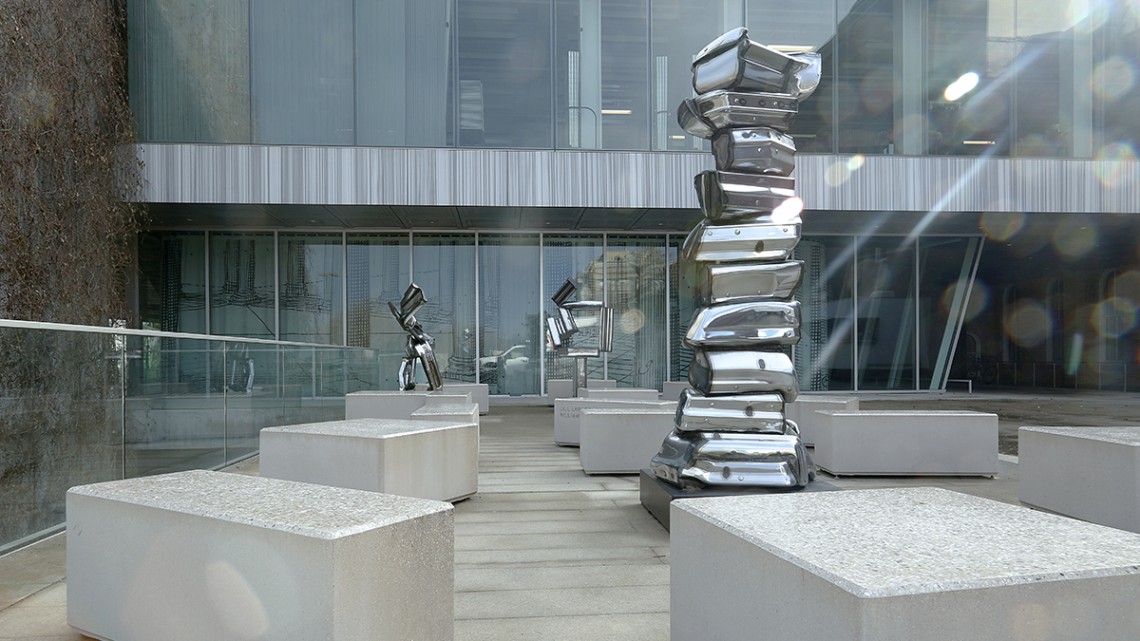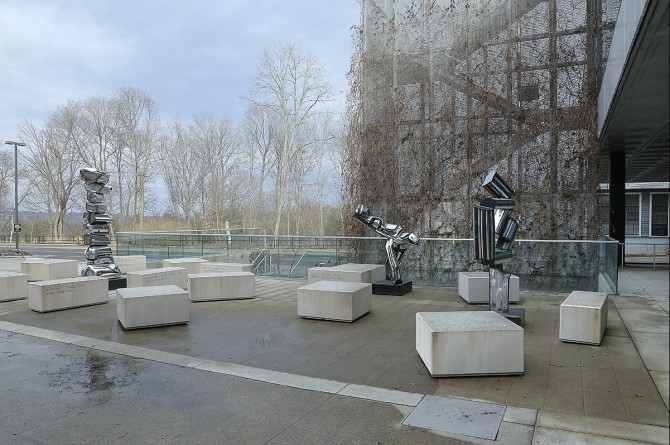
The Jason and Clara Seley Sculpture Court was recently installed on Sibley Plaza, featuring three chrome-plated steel sculptures. The eight-foot “Bookstack” is in the foreground.
Bumper crop of Seley sculptures installed near Sibley
By Daniel Aloi
Those sitting in the sun, studying, taking lunch or strolling on the plaza behind Sibley Hall will be in the company of three recently installed chromium-steel sculptures by former Cornell art professor and administrator Jason Seley ’40.
The Jason and Clara Seley Sculpture Court, completed in December, features works bequeathed to Cornell by Seley in 1983 – “Bookstack,” “Tsura” and “My Square.” The pieces are interspersed among the seating on the plaza near Franny’s food cart.
“The three Seley pieces are sited to mingle with the students, faculty and staff who regularly populate the plaza,” said Kent Kleinman, the Gale and Ira Drukier Dean of Architecture, Art and Planning (AAP). “Mounted directly on the concrete with only a minimal base, these are not monuments in any sense but rather more like old friends, slyly attentive to the life around them.”
“Bookstack,” 8 feet tall and 3 feet wide, was previously on display in the Fine Arts Library in Rand Hall, now under renovation and reopening in 2019. The other pieces were held in storage by the Herbert F. Johnson Museum of Art, which received Seley’s initial bequest. AAP is the custodian of the three works, which were installed in consultation with the museum, Kleinman and art faculty.
The sculpture court was made possible by a gift from the estate of Clara Seley, the artist’s widow, to display his works and “offer a space for study and reflection for students throughout the university.”
Seley joined the faculty in 1968 as professor and chair of the Department of Art after teaching sculpture at Hofstra University and New York University. He served as chair until 1973 and was dean of the College of Architecture, Art and Planning from 1980 until his death in 1983 at age 64.
As a student he was influenced to become a sculptor by professor of fine arts Kenneth Washburn ’26, MFA ’29. Seley began working with found objects in the 1950s and creating armature frameworks for plaster sculptures out of automobile bumpers, his eventual trademark.
In 1956, the Seleys purchased for a dollar a rear bumper from a 1949 Buick that Clara had found; Seley learned to weld and chrome bumpers informed his artistic practice from 1958 on. He once said his aim was to transform the material without obliterating its identity.
He also considered bumpers “inspirational,” he said in 1963. “I move them around. Put them together. Add. Subtract. Then, if all goes well, something exciting begins to happen.”
His 11-foot-tall “Herakles in Ithaka I” (1981), based on an ancient statue of Hercules, was his gift to the university in January 1983, prior to his death. It was installed outside Statler Hall in 1989 and restored and reinstalled in 2016.
Seley’s work is in several public collections including the Johnson Museum at Cornell, the Museum of Modern Art, the Whitney Museum of American Art, the Hirshhorn Museum at the Smithsonian Institution, the National Gallery of Canada in Ottawa, the Nelson A. Rockefeller Collection at Empire State Plaza in Albany and the New Jersey Cultural Center in Trenton.
The effort to create the sculpture court was spearheaded by Kleinman and AAP assistant dean Tom Cole, with the participation of Frank Parish, AAP director of facilities; art faculty members Michael Ashkin and Robert Bertoia; and Matt Conway, registrar at the Johnson Museum. It was completed after approvals from the university’s Committee on Memorials and Named Facilities and the Committee on Outdoor Art at Cornell.
Media Contact
Get Cornell news delivered right to your inbox.
Subscribe
